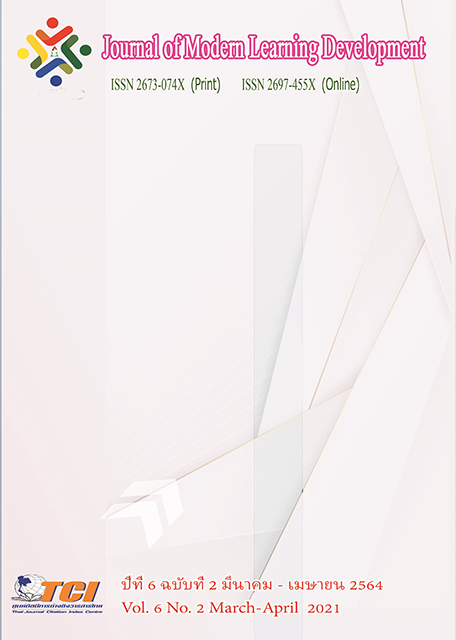An Analysis of Stock Returns in Consumer Product , Industry and Service Sector in the Market for Alternative Investment
Main Article Content
Abstract
The objective of this research is to (1) study the return of common stocks in the Market for Alternative Investment (2) to analyze the movement of the return of common stocks in consumer product, industry and service sector (3) to study the relationship between risk and returns of stocks in consumer product, industry and service sector (4) to specify factors that can explain the movement of returns for common stocks in consumer product, industry and service sector. The study uses closing price, price/earnings ratio, dividend yield, book/price ratio, share numbers, sales and beta of 12 listed company stocks in consumer product, industry and service sector in the Market for Alternative Investment by using data from 2015 to 2020 on a quarterly basis. The study uses econometric method by Panel Data Regression Analysis.
The result of the research presents that (1) The return on common stocks in the Market for Alternative Investment is between -66.7% to 155.2% per year. (2) The return on the Market for Alternative Investment in consumer product, industry and service sector by overall has a movement in the form of an N-shape structure.(3) The Beta of the previous period has not relationship to the return on common stocks in consumer product, industry and service sector. (4) The factors that can be used to describe the change in return on common stock in consumer product, industry and service sector are book/price ratio, dividend yield, size of listed company. ( =0.173)
Article Details
References
ตลาดหลักทรัพย์แห่งประเทศไทย. (2548). CISA ระดับ2 ทฤษฎีตลาดทุนและกระบวนการบริหารกลุ่มสินทรัพย์ลงทุน. กรุงเทพมหานคร: ตลาดหลักทรัพย์แห่งประเทศไทย.
ตลาดหลักทรัพย์แห่งประเทศไทย. (2563). โครงสร้างการจัดกลุ่มอุตสาหกรรมในตลาดหลักทรัพย์เอ็ม เอ ไอ (MAI). ออนไลน์. สืบค้นเมื่อ 18 พฤษภาคม 2563. แหล่งที่มา: ข้อมูลบริษัทจดทะเบียน:https://www.set.or.th/mai/th/company/industry_group_p1.html
ตลาดหลักทรัพย์เอ็ม เอ ไอ. (2559). Stock Focus 2016. กรุงเทพมมหานคร: ตลาดหลักทรัพย์เอ็ม เอ ไอ.
นิเวศน์ เหมวชิรวรากร. (2563). โลกในมุมมองของ VALUE INVESTOR : ฟองสบู่ NASDAQ VS MAI . เข้าถึงได้จาก กรุงเทพธุรกิจ : https://www.bangkokbiznews.com/blog/detail/633726
มนตรี พิริยะกุล (2559). Panel Data Analysis . ออนไลน์. สืบค้นเมื่อ 29 พฤษภาคม พ.ศ.2563 แหล่งที่มา: http://www.research.ru.ac.th/ArticleMr/indexView/39
Banz, Rolf W. (1981). The relationship between return and market value of common stocks. Journal of Financial Economics. 9 (1). 3-18.
Black, Fischer. (1972). Capital market equilibrium with restricted borrowing. Journal of Business Finance&Accounting. 45 (3). 444-455.
Charitou, Andreas , & Constantinidis, Eleni. (2004). Size and Book-to-Market Factors in Earnings and Stock Returns:Empirical Evidence for Japan. Ph.d Dissertation, Department of Business Administration. Cyprus: University of Cyprus.
Chen, Jianguo , Kan, Kwong Leong , & Anderson, Hamish. (2003). Size,Book/Market Ratio and Risk Factor Returns : Evidence from China A-Share Market. New Zealand: College of Business , Massey University.
Fama, Eugene F., & French, Kenneth R. (1992). The Cross-Section of Expected Stock Returns. The Journal of Finance. 17 (2). 427-465.
Fama, Eugene F., & French, Kenneth R. (1993). Common Risk Factors in the Returns on Stocks and Bond. Journal of Financial Economics. 3, 3-15.
Gu, Qian. (2015). Size and Book-to-Market Factors in Returns. Ph.D. Dissertation , Graduate Studies at Digital Common. USA : Utah State University.
Lintner, John. (1965). The valuation of risk asset and the selection of risk investments in stock
portfolios and capital budgets. The Review of Economics and Statistics. 47 (1),13-37.
Musallam, Sami RM. (2018). Exploring the Relationship between Financial Ratios and Market Stock. Eurasian Journal of Business and Economics. 11 (21), 101-116.
Sharpe, William F. (1964). Capital Asset Prices : A Theory of Market Equilibrium Under Conditions of Risk. The Journal of Finance, 19 (3), 425-442.
Wang, Fenghua & Xu, Yexiao. (2003). What Determines Chinese Stock Returns? Texas. USA: School of Management. The University of Texas at Dallas.


